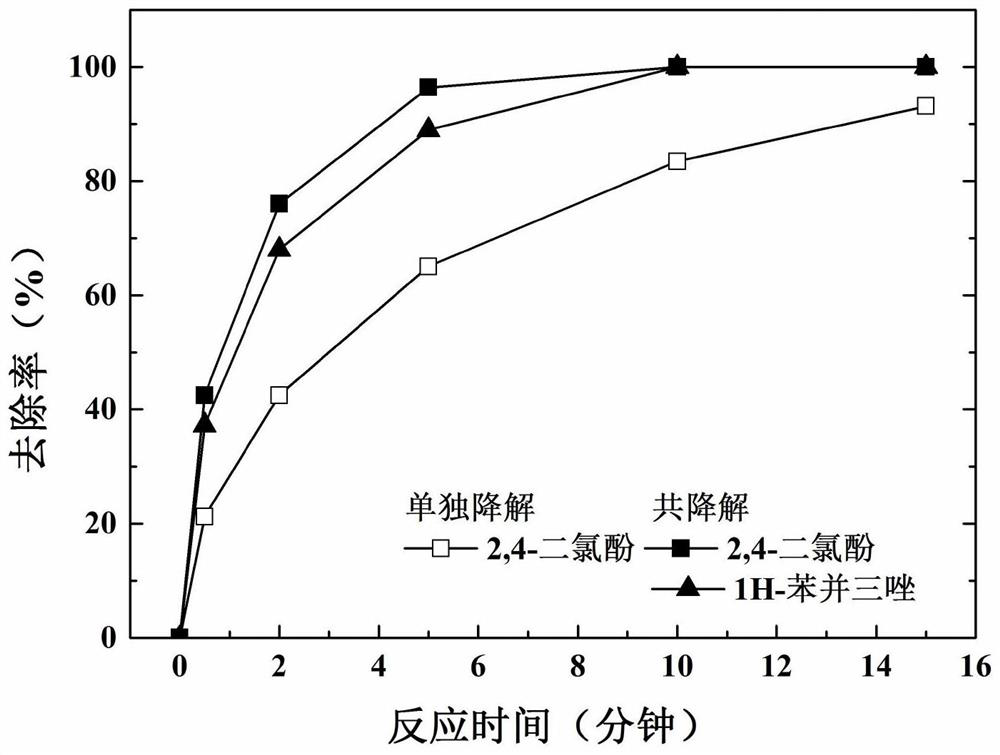A water treatment method that utilizes background pollutants to promote the formation of cu(iii) from trace copper ions
A technology of pollutants and copper ions, applied in the field of water pollution treatment, can solve the problems of increasing environmental risks and increasing treatment costs, and achieve the effects of convenient transportation and storage, reducing dosage, and promoting cyclic reactions
- Summary
- Abstract
- Description
- Claims
- Application Information
AI Technical Summary
Problems solved by technology
Method used
Image
Examples
Embodiment 1
[0038] 1. Take 6 parts of 200ml distilled water and prepare 2,4-dichlorophenol pollutant solution, 1,4-dioxane pollutant solution, benzothiazole pollutant solution, sulfa Methoxazole pollutant solution, atrazine pollutant solution, toluene pollutant solution, adjust the pH value of 6 parts of water samples to be treated to 8 with borate and sodium hydroxide;
[0039] 2. Add potassium monopersulfate and copper sulfate solutions sequentially to the 6 water samples to be treated, so that the concentration of potassium monopersulfate is 400 μmol / L, and the concentration of copper ions is 10 μmol / L. At the same time, each pollutant water sample Do the contrast samples of adding potassium monopersulfate separately and adding copper sulfate solution separately;
[0040]3. Fully stir the 6 parts of the water sample to be treated and the reference sample, without aeration during the reaction, take them out after 15 minutes of reaction, and measure the remaining 1,4-dioxane in the sampl...
Embodiment 2
[0043] 1. Take 100ml of distilled water and prepare a 2,4-dichlorophenol pollutant solution with a concentration of 20 μmol / L, and adjust the pH value of the water sample to be treated to 8 with borate and sodium hydroxide;
[0044] 2. Take 100ml of distilled water and prepare a 1H-benzotriazole pollutant solution with a concentration of 10μmol / L, and adjust the pH value of the water sample to be treated to 8 with borate and sodium hydroxide;
[0045] 3. Mix the above two water samples to be treated at a volume ratio of 1:1, so that the concentration of 2,4-dichlorophenol in the mixed water sample is 10 μmol / L, and the concentration of 1H-benzotriazole is 5 μmol / L;
[0046] 4. Add potassium monopersulfate and copper sulfate solution sequentially to the mixed water sample to be treated, so that the concentration of potassium monopersulfate is 400 μmol / L, and the concentration of copper ion is 10 μmol / L. Contaminant water samples (10μmol / L) were subjected to comparative degradat...
specific Embodiment 3
[0050] In specific embodiment 3, the pH value of the water sample to be treated in step 1 and step 2 is adjusted to 7, 9, 10, and other steps are the same as in embodiment 2. Under the conditions of pH 7, 9, and 10 in water, the presence of 1H-benzotriazole can promote the removal of 2,4-dichlorophenol to varying degrees, and 1H-benzotriazole has also been effectively When the removal rate of 2,4-dichlorophenol reaches 100%, the removal rate of 1H-benzotriazole can reach more than 90%. It can be seen that the water treatment decontamination method using benzotriazole pollutants in the background of water to promote trace copper ions to catalyze monopersulfate to form Cu(III) is applicable to a wide range of pH.
PUM
 Login to View More
Login to View More Abstract
Description
Claims
Application Information
 Login to View More
Login to View More - R&D Engineer
- R&D Manager
- IP Professional
- Industry Leading Data Capabilities
- Powerful AI technology
- Patent DNA Extraction
Browse by: Latest US Patents, China's latest patents, Technical Efficacy Thesaurus, Application Domain, Technology Topic, Popular Technical Reports.
© 2024 PatSnap. All rights reserved.Legal|Privacy policy|Modern Slavery Act Transparency Statement|Sitemap|About US| Contact US: help@patsnap.com










